Ditzner Exam 3
1/58
Earn XP
Description and Tags
These flashcards cover definitions and key concepts related to metabolism, metabolic pathways, and glycolysis as discussed in the lecture notes.
Name | Mastery | Learn | Test | Matching | Spaced |
|---|
No study sessions yet.
59 Terms
Digestion
The first stage of metabolism; the process of breaking down larger molecules into smaller units that may be absorbed and utilized.
Metabolism
A highly integrated network of chemical pathways that enable a cell to extract energy from the environment to sustain life.
Metabolism: a highly integrated network of chemical pathways that enable a cell to extract energy from the environment to sustain life
____ (movement)
____________
_________________
___________
Work, Active transport, signal transduction, biosynthesis
Catabolism
Reaction pathways that break down fuel and provide energy.
Anabolism
Reaction pathways that use energy to synthesize biomolecules.
Glycolysis
The breakdown of one molecule of glucose to two molecules of pyruvate; occurs entirely in the cytoplasm.
Glycolysis: the breakdown of 1 molecule of glucose (annd other monosaccharides) to 2 molecules of pyruvate (catabolic), occurs entirely in the cytoplasm
Net Reaction: ______ converted to 2 molecules of _______ via _______
2 ____ are reduced to 2 ____
2 ___→2 ___ (net)
Net ________ where change of G=____ kcal/mole
glucose, pyruvate, oxidation, NAD+, NADH, ADP, ATP, exothermic, -23
Gluconeogenesis
The synthesis of glucose from non-carbohydrate precursors, mainly occurring in the liver.
Metabolism
Knowledge of normal metabolism is essential to understanding abnormalities that underlie _______
Normal metabolism includes adaptation to periods of _______, _________, and _______; pregnancy and lactation
Abnormal metabolism may result from _________ or ______ deficiencies, abnormal secretion of ________, or the actions of _____ or ______
________ of metabolic fuels provides the energy needed to generate ___ from ___ and the building blocks needed for _____
disease, fasting, starvation, exercise, nutritional, enzyme, hormones, drugs, toxins, oxidation, ATP, ADP, growth
Irreversible=catalyzed by different ________ in different ___________
________ pathways, ___________ regulated by enzymes unique to each → don’t occur at the ____ time
enzymes, directions, reverse, reciprocally, same
Tissue/Organ Level of Metabolism: ________ entering and __________ leaving tissues and organs can be measured and regulated
E.g. regulation of blood glucose level by the _____
Between meals: liver breaks down ______ to liberate ______ to be used by _____ cells, ___, ____ cells, etc.
After a meal: excess ________ is converted into _______ or ___ stored between
substrates, metabolites, liver, glycogen, glucose, muscle, RBCs, brain, glucose, glycogen, fat
Sub-Cellular Level of Metabolism: each ________ or ___________ has specific roles
__________ plays a central role
Permits __________ and __________ of metabolic pathways at the _________ level
organelle, compartment, mitochondria, integration, regulation, molecular
_________ of Carbohydrates, Proteins, and Fats
All pathways lead to ________
Acetyl-CoA is ________ cleaved in Citric Acid Cycle to give ___ and ___
Electrons “_________” in the Citric Acid Cycle are used to generate more ___ in the ____
Harvested in the form of _________ (ATP)
Catabolism, acetyl-CoA, oxidatively, CO2, ATP, harvested, ATP, ETC, electrons
Acetyl-CoA
A central compound in the metabolism of carbohydrates, fats, and amino acids.
Citric Acid Cycle
A cyclic pathway that oxidatively cleaves acetyl-CoA to produce CO2 and ATP.
____________ metabolism (aerobically):
Major fuel=_______ from ____
Metabolized to _______ via _______
Pyruvate ________ converted to acety-CoA
Acetyl CoA further metabolized via _____________ and ___ to ___, ___ with concomitant generation of ATP
Other pathways involved:
______________ Pathway (ribose phosphate→RNA/DNA OR Triose Phosphate→Pyruvate)
Gluconeogenesis (______)
Glycogenolysis (_______)
Carbohydrate, glucose, diet, pyruvate, glycolysis, aerobically, Citric Acid Cycle, ETC, CO2, H2O, Pentose Phosphate, anabolic, catabolic
______ Metabolism (Beta-Oxidation):
Major fuel=________ from ____ (hydrolyzed from __________)
FA converted to ______ via Beta-Oxidation which can:
Feed into the Citric Acid Cycle and ETC
Serve as a ________ for synthesis of other ______ (e.g. cholesterol, steroids)
Be converted to _________ in liver as fuel during ___________
Lipid, fatty acids, diet, triacylglycerols, acetyl-CoA, precursor, lipids, ketone bodies, fasting/starvation
_________ Metabolism (Transamination/transfer of ___________):
Proteins are first broken down to __
AA are required for ______________
Some (essential) AA must be supplied by diet
Others can be synthesized from other sources (____________)
____ is a byproduct of AA _________
Protein, amino groups, AA, protein synthesis, diet, carbohydrates, Urea, catabolism
ATP
The energy currency of the cell, powering reactions that require free energy.
All steps in the metabolic pathway are _____________
Most steps are _______ (activity is not ________) → _______________
Irreversible steps typically catalyzed by ____________, activity of which is ________ (either by another substrate within the pathway and/or other factors)
enzyme-catalyzed, reversible, regulated, michaelis menten, allosteric enzymes, regulated,
Bioenergetics
Biochemical thermodynamics or the study of energy changes accompanying biochemical reactions.
Exergonic Reaction
A spontaneous reaction where the change of free energy (ΔG) is less than zero.
Endergonic Reaction
A non-spontaneous reaction where the change of free energy (ΔG) is greater than zero.
E of products<E of reactants is __________
favorable
Endergonic reactions are “_____” with exergonic reactions further down the path to make it net _______ or _________
coupled, exergonic, favorable
The _____ and ______ the bioenergetic/change of G graph of reaction is, the more irreversible to reaction can be
The ______ and _____ the bioenergetic/change of G of reaction is, the more reversible to reaction can be
taller, narrow, shorter, wider
The energy released by exergonic reactions are used to ____ endergonic reactions
The individual steps of a metabolic pathway are ______
___ is considered the energy “currency” of the cell
ATP→ADP + Pi (change of G=__ kcal/mol)
ATP→ADP is _________
Exergonic, mainly because of increased _________ energy of the free vs bound _______ (Pi)
Reactions that _______ free energy are powered by ATP→ADP
Reactions that _______ free energy power ADP→ATP
fuel, linked, ATP, -7, favorable, resonance, phosphate, require, release
Phosporyl Transfer Energy: estimated by change of G of _________ of the _____________ compound
Can be transferred from a compound with a _______ potential to a compound with ____ potential
Increased change of G = increased ___
hydrolysis, phosphorylated, greater, less, PTE
Phosphoenolpyruvate (___) and 1,3-Biphosphoglycerate (______) can transfer a __ → ___ to generate ATP
______________ and ___ (to ADP) = “ATP is the cell’s energy currency”
ATP can transfer a Pi (w/o the Pi group) to ______-phosphate, __________ (PPi), _________-phosphate, and __________-phosphate
PEP, 1,3-BPG, Pi, ADP, creatine phosphate, ATP, Glucose 1, Pyrophosphate, Glucose 6, Glycerol 3
_________ pathways are comprised of oxidation reactions
_________ pathways are comprised of reduction reactions
Oxidaiton and Reduction reactions are always ______:
if a subtraction is oxidized, whatever it reacted with is _______
Catabolic, anabolic, coupled, reduced
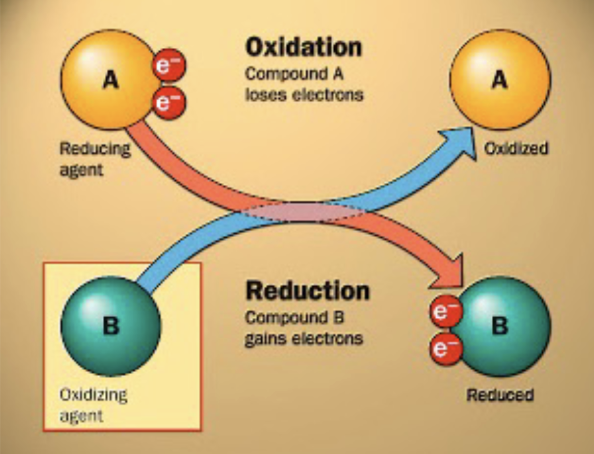
Electrons are typically transferred as ________ in redox reactions
(_) change of G = gives energy
(_) change of G = requires energy
Oil RiG
Oxidation: ________ # of C-X bonds, increased oxygens or double bonds
Reduction: ________ # of C-X bonds, decreased oxygens or double bonds
hydride (H-), -, +, increases, decreases
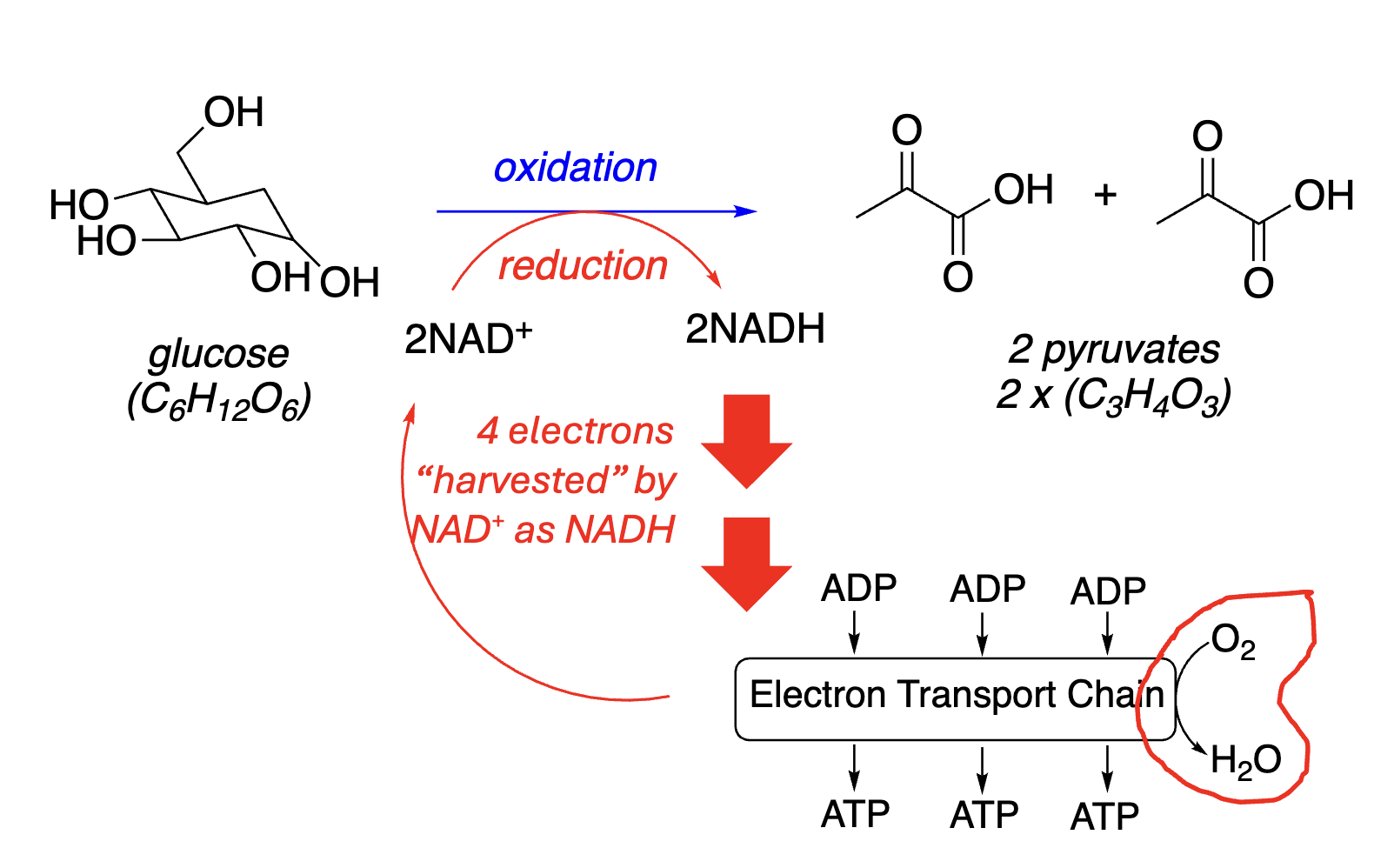
Explain how catabolic oxidation reactions fuel ATP synthesis.
2NAD+ is the oxidizing agent and Oxygen is present
Identify common redox reagents/electron “carriers” of metabolic pathways:
________: nicrotinamide adenine dinucleotide
________: Flavin adenine dinucleotide
NAD+/NADH, FAD/FADH
Redox Reactions
Reactions that involve the transfer of electrons between two species; always coupled.
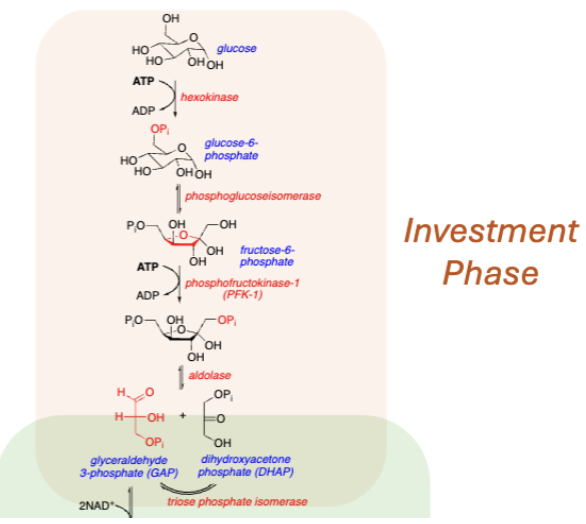
Glycolysis Investment Phase
The first five steps of glycolysis that require an investment of ATP.
Investment Phase of Glycolysis: first 5 steps that uses 2 ATPs
1 molecule of ______ → 2 molecules of glyceraldyhyde 3-phosphate (________)
Requires _ equivalents of ATP
________ (6-carbon ring) → 2 _______ (3-carbon chains)
Produces 2 molecules of ___ proceed thru remaining 5 steps
Catalyzed by ________ enzyme (irreversible steps)→ Steps , , and _
Michaelis Menten = __________-
glucose, converted, 2, Pyranoses, trioses, GAP, allosteric, 1, 3, 10, irreversible
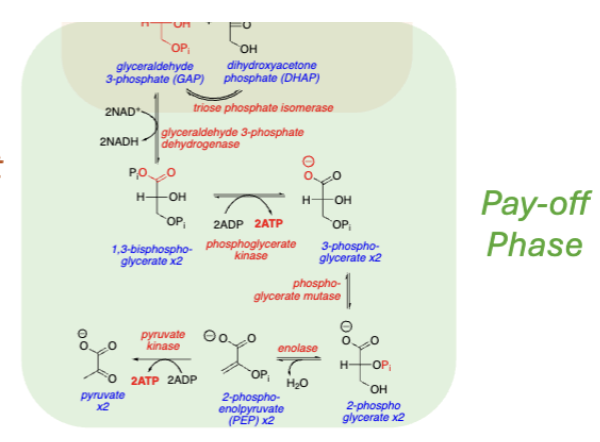
Glycolysis Pay-Off Phase
The remaining five steps of glycolysis that yield a net production of ATP.
Pay-Off Phase of Glycolysis: remaining 5 steps that yields 4 ATPs
2 molecules of ___ → 2 molecules of pyruvate (_______)
_ equivalents of ATP produced thru “_____________________”
2 equivalents of ____ → ____ (_______)
1 molecule of glucose = ______ ATP (_ from substrate level/glycolysis)
Most come from ETC___
GAP, oxidized, 2, substrate-level phosphorylation, NAD+, NADH, reduced, 30-32, 2, ETC
Glycolysis Step 1:
Glucose → ________________ (______________)
_________ catalyzed by _______
Phosphate transferred from ___ to ______
Hexokinase has ___ affinity for glucose
A key __________ enzyme
glucose-6-phosphate/glycogen, phosphorylated, Irreversibly, hexokinase, ATP, glucose, high, regulatory
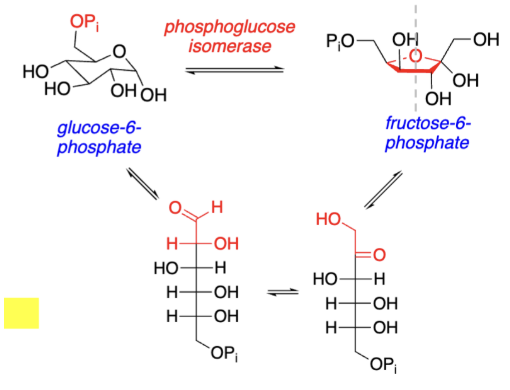
Glycolysis Step 2:
Glucose-6-Phosphate/glycogen → _____________ (__________)
_________ reaction catalyzed by _________________
___________ isomerization; 6-membered ring→5-membered ring thru ____ chain
_____ % is in the form with the structure on the bottom left
fructose 6-phosphate, isomerized, Reversible, phosphoglycose-isomerase, Aldose-to-ketone, open, small
Glycolysis Step 3:
Fructose-6-phosphate → ______________ (_________________)
Catalyzed by phosphofructo-kinase-1 (_______)
Consumes ___ equivalent of ATP
Irreversible, key regulatory step of glycolysis
Regulated by _________ enzyme
fructose-1,6-biphosphate, 2nd phosphorylation, PFK-1, 2nd, regulatory, allosteric
Glycolysis Step 4:
6-carbon furanose → ___________________ (______/breaks apart)
Cleaved into glyceraldehyde 3-phosphate (___) and dihydroxyacetone phosphate (____)
_________ reaction reversibly catalyzed by _______
2 3-carbon triose phosphates, cleaved, GAP, DHAP, Retro-aldol, aldolase
Glycolysis Step 5:
____ → ___ (_____________)
Catalyzed by _____________________
2 ____ continues thru the glycolysis pathway
DHAP, GAP, reversible isomerization, triose phosphate isomerase, GAPs
Glycolysis Step 6:
GAP → ___________ (________ by NAD+, exergonic, electrons harvested, redox rxn)
1st step of “_______” phase
__________; catalyzed by _______________________
NAD+ _______ to NADH; phosphorylation by _______ phosphate
_______ reduced 2NAD+ to NADH
1,3-bisophosphoglycerate, oxidized, payoff, reversible, glyceraldehyde 3-phosphate dehydrogenase, reduced, inorganic, Hydride (H-)
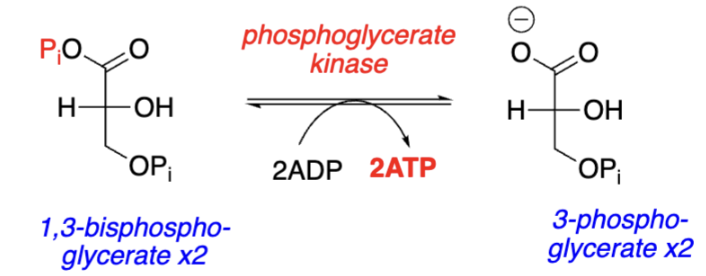
Glycolysis Step 7:
1,3-BPG → ______________ (phosphate __________)
1,3-BPG is a ____ energy compound (high PTE)
Phosphate transferred from 1,3-BPG → ___ to generate ATP (2 total) and give 3-phosphoglycerate (______________________)
_________; catalyzed by ___________________
3-phosphoglycerate, transferring, high, PTE, ADP, substrate level phosphorylation, Reversible, phosphoglycerate kinase
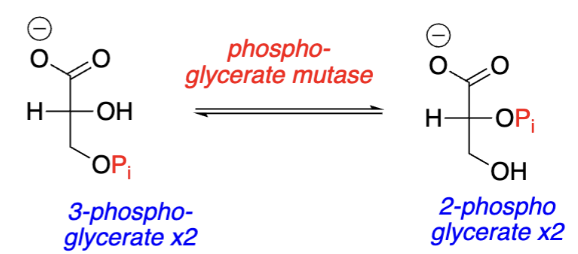
Glycolysis Step 8:
3-phosphoglycerate → _______________ (____________ and phosphate ________)
________; catalyzed by ___________________
2-phosphoglycerate, isomerization, transferring, Reversible, phosphoglycerate mutase
Glycolysis Step 9:
2-phosphoglycerate → ______________ (PEP) (__________)
_________; catalyzed by ______
___ is another high-energy phosphate (high phosphoryl transfer potential=transfer Pi group to _________)
2-phosphoenolpyruvate, dehydration, Reversible, enolase, PEP, anything
Glycolysis Step 10:
2-phosphoenolpyruvate → __________________ (_____________________)
___ transfers a phosphate to ___ to generate ___; _____________________
_________; catalyzed by ______________
pyruvate/pyruvic acids, enol-to-keto tautomerization PEP, ADP, ATP, substrate level phosphorylation, Irreversible, pyruvate kinase
Aerobic Conditions:
_______ is further oxidized in ____________ via _______________ and ___
This _______ NAD+ which is in _____ supply in cells
Glycolysis can continue to breakdown more glucose
NADH _______ to NAD+ (_____________) and O2 _________ to H2O (__________) in ETC
Pyruvate, mitochondria, Citric Acid Cycle, ETC, replenishes, short, oxidized, mitochondria, reduced, cytoplasm
Anaerobic Conditions:
Not enough __ in the mitochondria to ________ NAD+
Another source of ____necessary for glycolysis to continue
Mainly occurs in ______________ cells
O2, replenish, NAD+, actively respiring muscle
Step “__” of Glycolysis
Pyruvate → ______ (reduced by ____)
NADH ________ to NAD+ and glycolysis continues
11, lactate, NADH, oxidized,
Cori Cycle
The process where lactate produced in muscles is transported to the liver and converted back to pyruvate.
Gluconeogenesis
______ of glycolysis, but only in the synthesis of _ molecule of glucose from _ molecules of pyruvate
Occurs in _____ (starvation); glucose required by ______ and ____
Key Differences:
Starts with pyruvate in mitochondra; several additional prep steps needed
______________ FOR PYRUVATE in mitochondrial membrane
Pyruvate → _________ → _______ (transported) → _________ → ___
Eats up 2 ____ and 2 ____
________ oxidized to malate in ________
______ reduced to Oxaloacetate in ________
Requires _ ATP equivalents
Key regulatory steps are catalyzed by enzymes that are different than for glycolysis (Steps _, _, and _)
It’s also net exothermic (has to be) but by much ____ (change of G=__ kcal/mol)
Reverse, 1, 2, liver, brain, RBCs, no transporter, oxaloacetate, malate, oxaloacetate, PEP, ATPs, GTPs, Oxaloactetae, mitochondria, Malate, cytoplasm, 6, 1, 3, 10, less, -9
For the regulation of glycolysis and gluconeogenesis, 2 pathways are not active at the same time
When 1 pathway is activated, the other is _______
Regulated by the ________ enzymes distinct to each pathway
_____ (glycolysis) or _________ (gluconeogenesis)
___________ (glycolysis) or ______ (gluconeogenesis)
In most tissues, gluconeogenesis stops with formation of ____________, which is converted to glycogen and stores
Last step of gluconeogenesis occurs primarily in _____ cells; maintains ___________ levels
Activated or inactivated by various _________ or _________ (glucagon, insulin)
inhibited, allosteric, PFK-1, F-1,6-BP, Hexokinase, G-6P, glucose 6-phosphate, liver, blood glucose, metabolites, hormones
Reciprocal Regulation
The regulation where one pathway is activated while the other is inhibited, balancing metabolic needs.
When energy stores are high
Glycolysis ________
Gluconeogenesis ________
inactivated, activated
When energy stores are low
Glycolysis ________
Gluconeogenesis ________
activated, inactivated
Allosteric activators/inactivators include:
___, ____ (activators)
___, ___, ___ (inactivators)
F-2, 6-BP, ATP, ADP, AMP
NAD+/NADH and FAD/FADH
Common electron carriers in metabolic pathways involved in redox reactions.